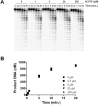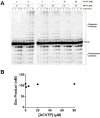Effects of Acyclovir, Foscarnet, and Ribonucleotides on Herpes Simplex Virus-1 DNA Polymerase: Mechanistic Insights and a Novel Mechanism for Preventing Stable Incorporation of Ribonucleotides into DNA
- PMID: 26836009
- PMCID: PMC5551684
- DOI: 10.1021/acs.biochem.6b00065
Effects of Acyclovir, Foscarnet, and Ribonucleotides on Herpes Simplex Virus-1 DNA Polymerase: Mechanistic Insights and a Novel Mechanism for Preventing Stable Incorporation of Ribonucleotides into DNA
Abstract
We examined the impact of two clinically approved anti-herpes drugs, acyclovir and Forscarnet (phosphonoformate), on the exonuclease activity of the herpes simplex virus-1 DNA polymerase, UL30. Acyclovir triphosphate and Foscarnet, along with the closely related phosphonoacetic acid, did not affect exonuclease activity on single-stranded DNA. Furthermore, blocking the polymerase active site due to either binding of Foscarnet or phosphonoacetic acid to the E-DNA complex or polymerization of acyclovir onto the DNA also had a minimal effect on exonuclease activity. The inability of the exonuclease to excise acyclovir from the primer 3'-terminus results from the altered sugar structure directly impeding phosphodiester bond hydrolysis as opposed to inhibiting binding, unwinding of the DNA by the exonuclease, or transfer of the DNA from the polymerase to the exonuclease. Removing the 3'-hydroxyl or the 2'-carbon from the nucleotide at the 3'-terminus of the primer strongly inhibited exonuclease activity, although addition of a 2'-hydroxyl did not affect exonuclease activity. The biological consequences of these results are twofold. First, the ability of acyclovir and Foscarnet to block dNTP polymerization without impacting exonuclease activity raises the possibility that their effects on herpes replication may involve both direct inhibition of dNTP polymerization and exonuclease-mediated destruction of herpes DNA. Second, the ability of the exonuclease to rapidly remove a ribonucleotide at the primer 3'-terminus in combination with the polymerase not efficiently adding dNTPs onto this primer provides a novel mechanism by which the herpes replication machinery can prevent incorporation of ribonucleotides into newly synthesized DNA.
Figures









References
-
- Crumpacker CS, Schnipper LE, Chartrand P, Knopf KW. Genetic mechanisms of resistance to acyclovir in herpes simplex virus. Am J Med. 1982;73:361–368. - PubMed
-
- Crumpacker CS, Chartrand P, Subak-Sharpe JH, Wilkie NM. Resistance of herpes simplex virus to acycloguanosine–genetic and physical analysis. Virology. 1980;105:171–184. - PubMed
-
- Coen DM, Schaffer PA, Furman PA, Keller PM, St Clair MH. Biochemical and genetic analysis of acyclovir-resistant mutants of herpes simplex virus type 1. Am J Med. 1982;73:351–360. - PubMed
Publication types
MeSH terms
Substances
Grants and funding
LinkOut - more resources
Full Text Sources
Other Literature Sources

